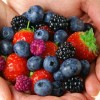The purpose of this new 9-page paper, written by David Jarnagin, Ali Sarkhosh, Juanita Popenoe, Steve Sargent, and Kevin Athearn, and published by the UF/IFAS Horticultural Sciences Department, is to provide information on growing American elderberry in Florida as an alternative crop for commercial growers as well as homeowners. Although elderberry has been historically grown at commercial scale in some world regions, especially throughout Europe, in the New World it has not found meaningful commercial acceptance until recently.
https://edis.ifas.ufl.edu/hs1390
Tag: Berries
Survival of Foodborne Pathogens on Berries
 Fresh and frozen berries are popular foods. When berries are picked for fresh consumption, they are usually packed directly without washing because they are highly perishable. There is typically no “kill step” that would eliminate pathogens on fresh or frozen berries. Foodborne illness outbreaks have been associated with the consumption of fresh or frozen berries that were contaminated with pathogenic viruses, parasites, or bacteria. Contamination can occur before or during harvest or during final preparation. This 11-page fact sheet was written by Mary Palumbo, Linda J. Harris, and Michelle D. Danyluk, and published by the UF Department of Food Science and Human Nutrition, November 2014.
Fresh and frozen berries are popular foods. When berries are picked for fresh consumption, they are usually packed directly without washing because they are highly perishable. There is typically no “kill step” that would eliminate pathogens on fresh or frozen berries. Foodborne illness outbreaks have been associated with the consumption of fresh or frozen berries that were contaminated with pathogenic viruses, parasites, or bacteria. Contamination can occur before or during harvest or during final preparation. This 11-page fact sheet was written by Mary Palumbo, Linda J. Harris, and Michelle D. Danyluk, and published by the UF Department of Food Science and Human Nutrition, November 2014.
http://edis.ifas.ufl.edu/fs236
Outbreaks of Foodborne Illness Associated with Common Berries, 1983 through May 2013
 This 9-page fact sheet serves as a reference for anyone concerned about the safety of fresh and frozen berry products. Providing information for those who grow, harvest, process, transport, and serve berries to consumers is important for improving science-based food safety programs for the entire supply chain. Table 1 lists the reported outbreaks of foodborne illness from 1983 through May 2013 in which specific berries and mixed berries have been identified as the food vehicle. Table 2 lists the reported outbreaks in which berries were likely the food vehicle.
This 9-page fact sheet serves as a reference for anyone concerned about the safety of fresh and frozen berry products. Providing information for those who grow, harvest, process, transport, and serve berries to consumers is important for improving science-based food safety programs for the entire supply chain. Table 1 lists the reported outbreaks of foodborne illness from 1983 through May 2013 in which specific berries and mixed berries have been identified as the food vehicle. Table 2 lists the reported outbreaks in which berries were likely the food vehicle.
Written by M. Palumbo, L. J. Harris, and M. D. Danyluk, and published by the UF Department of Food Science and Human Nutrition, November 2013.
http://edis.ifas.ufl.edu/fs232
